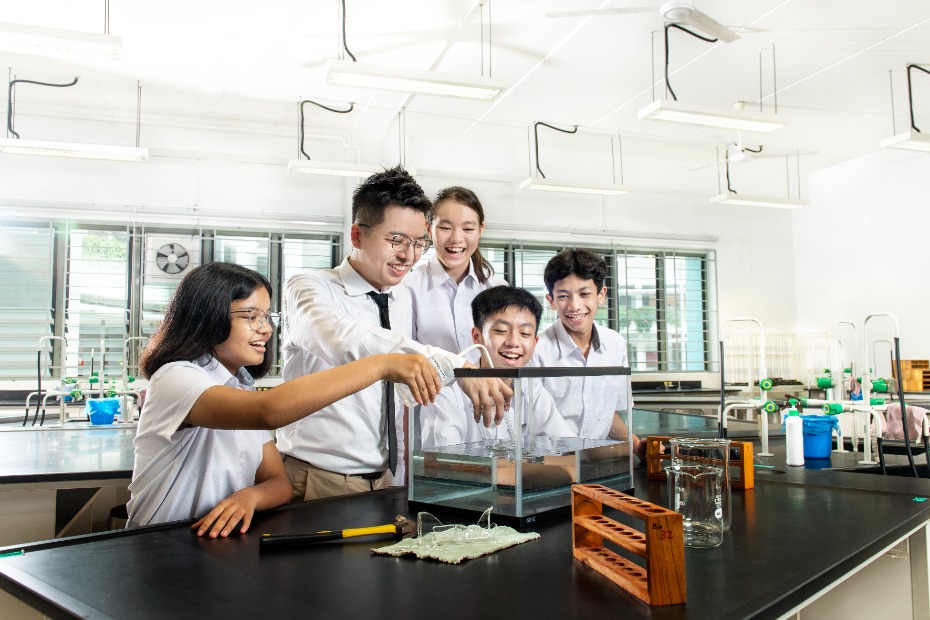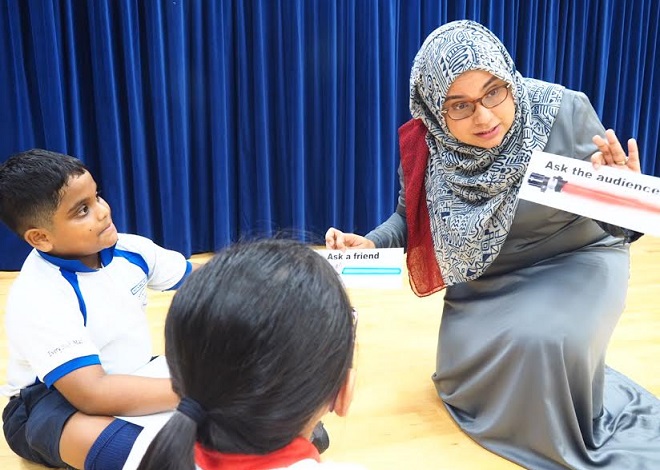What inspires you to teach?
“How does cling wrap work?”
In under three minutes, Secondary 2 student John* gave his explanation to the class. “It’s because of static electricity,” he began, as he unravelled the roll of cling wrap he brought.
“When you unroll a cling wrap, some electrons are pulled away from one layer to another, creating areas of positive and negative charges. When you wrap it around another surface, the electrostatic charge induces an opposite charge and the two stick together.” Watching him, it’s hard to imagine that John is usually shy and wouldn’t make eye contact nor speak up in class. But during his presentation, the class was rapt with attention. My heart swelled with pride.
The show-and-tell is titled “3 Minutes of Wonder!”, a pre-lesson activity that I shape for my students to be excited about Science. Students pick any topic that interests them and share their findings. For instance, a student whose family member snores wanted to find out what causes it. Other questions they’ve answered include “Why is the sky blue?” and “What causes bruises?”.
When students are interested in a topic, they will learn better, share more easily about the topic and grow in confidence.
I regularly prepare my own version of show-and-tell with them by using unexpected ways to teach a concept. During one lesson, I shattered a glass beaker (safely, of course) then poured the broken pieces into a container of what I called “self-repairing fluid”. Then I waved my hand over the container and voila! I pulled out a fully restored beaker.
The class gasped. Even the usually inattentive students sat up straight. “Wait, what?” they shouted from all corners of the classroom. “How does this even work?”
The “magic” is due to the fluid having the same optical density as the shattered beaker. The shattered pieces will hence appear to vanish when poured into the liquid. I simply planted an identical beaker inside the fluid and carefully fish it out later. This was a lesson on the refraction of light, which the students still talked about weeks after.
I believe that when students find joy and meaning in learning, every child wants to and can learn.
Describe a teaching approach you have found effective.
A group of students crowded around the teacher’s bench at the Science lab, clamouring to have a closer look at the object on display.
They were looking at coffee beans.
More specifically, students were exploring the 3D molecular structure of coffee beans. Each student now owns a Personal Learning Device, which helps make lessons pop out at them – sometimes literally. I had placed an AR card beside the coffee beans, and when student hovered the device over it, it was as if the molecule pops up from the object.
There were other everyday objects for students to scan, such as black pepper, lemon juice, and pen ink. There were many “ooh”s and “aah”s, which inspired me to find new ways to leverage technology for learning.

Educational technology has been revolutionising teaching, even for the development of empathy. When learning about the eye in Biology, for example, I brought students to walk around the school and look at their surroundings through their devices. Through an application, the surroundings appeared blurry with dark patches.
This was a small simulation of the daily challenges faced by those living with eye conditions such as cataracts and glaucoma. Students did comment that they didn’t know that it was so “serious” and inconvenient for the elderly and their grandparents who have these conditions. They launched into a discussion themselves on how they could be more proactive in helping their family members who might need help.
Which school initiative are you especially proud of?
When I was a teenager, a group of friends excluded me from their circle and stopped talking to me.
I did not feel like I belonged anywhere, did not look forward to school, and kept to myself almost all the time.
It was a teacher who noticed my wordless distress. She encouraged me to pen my thoughts in a journal, which made it easier for me to share my thoughts with her later.
Today, as the school’s Subject Head ICT, I oversee a school-wide, electronic version of that journal – a school-based student portal that allows teachers to get a quick sense of their students’ mood and check in on their well-being. Twice a week during assembly, students pen down their thoughts and feelings through weekly mood logs and reflection questions about their week. They also respond to questions about self-care, gratitude, resilience and a healthy identity.
In one instance, the question of the week was: “What is your greatest strength?” One student replied, “I am tall, that’s about it.”
I responded to affirm him on the great job he has been doing as our class’ Sustainability Rep, a point he didn’t realise he could give himself some credit for.
To the question “If you could make a wish to a genie, what would it be?”, one reply came to us as “I wish my friends would talk to me again”. That student’s form teachers attended to this response, bringing the student together with her friends to resolve the misunderstanding between them.
“I hope this provides a secure space for my students to openly share what they are feeling, in the same way that my teacher made me feel safe.”
Mr Seow Tzer Yeun
The programme also does a sentiment analysis of words used, and sends automated emails to alert the teachers if some negative sentiments show up, especially from the usually quieter students. Technology can help us provide timely intervention to students who are struggling and take preventive rather than reactive steps in extending support.
Above all, I hope this provides a secure space for my students to openly share what they are feeling, in the same way that my teacher made me feel safe.
*Not his real name





.jpg)
